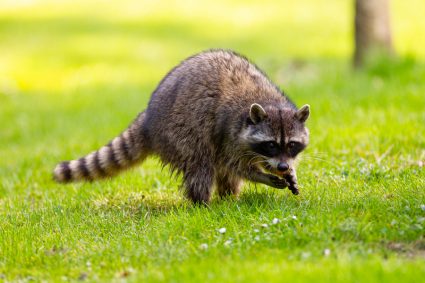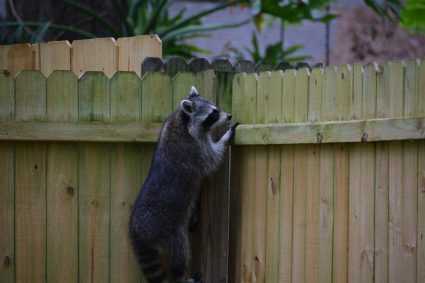
Skunks, with their distinctive black and white coloring and potent spray, are a common sight in many parts of North America. While they play a crucial role in controlling pests such as insects and rodents, they can become a nuisance when they take up residence near human habitats. If you’ve noticed signs of a skunk den on your property and are wondering how to get rid of it, you’ve come to the right place. This comprehensive guide will walk you through the process of identifying, removing, and preventing skunk dens.
To get rid of a skunk den, first confirm it’s a skunk den by identifying tracks, droppings, odor, cone-shaped holes in your lawn, or alerted dogs. Start the removal process slowly by loosely filling the entrance to their burrow with leaves or newspaper, use repellents, remove food sources, and install lights. If these methods fail, call a professional. To prevent their return, seal off potential dens, remove food sources, use repellents, and modify the habitat to make it less appealing to skunks. Always approach skunks with caution to avoid getting sprayed.
Identifying a Skunk Den
Before you can get rid of a skunk den, you need to be sure that you’re dealing with skunks. Here are some signs that indicate the presence of a skunk den in or around your property:
- Tracks: Skunks have five toes on each foot and their prints are generally easy to identify.
- Droppings: Skunk feces are similar to cat waste but contain bits of undigested seeds and insects.
- Odor: Skunks produce a musky scent around their den, even when they don’t spray.
- Cone-shaped holes in your lawn: Skunks dig in search of grubs and lawn insects, leaving behind distinctive holes.
- Barking dogs: Dogs often sense the presence of a skunk before humans do, and their behavior can alert you to a skunk’s presence.
Risks Associated with Skunk Dens
Having a skunk den on your property can pose several risks, from damage to your lawn and garden to potential health hazards. Skunks are known to carry diseases like rabies and can also attract other pests. Their notorious spray is not only unpleasant but can cause temporary blindness and nausea.
Removal Methods
Once you’ve confirmed the presence of a skunk den, it’s time to take action. Here are some effective and humane methods to remove skunks from your property.
Start Slowly
Skunks are generally non-aggressive and can take a hint. If you loosely fill the entrance to their burrow with leaves or newspaper, they’ll likely move on to a new location.
Use Repellents
Skunks have a sensitive sense of smell and can be deterred by strong odors. A homemade pepper spray can be effective, as can commercial repellents available at most garden centers.
Remove Food Sources
Secure your trash bins and avoid leaving pet food outside. Empty bird feeders for a while to deter skunks attracted to the seeds.
Install Lights
Skunks are nocturnal and can be deterred by bright lights. Consider installing motion-activated security lights around the den area.
Call a Professional
If these basic remedies don’t work, consider bringing in the professionals. Wildlife control services can remove skunks safely and humanely.
Preventing Return
Once the skunks have been removed, it’s important to take steps to prevent them from returning. This can be achieved by sealing off potential dens, removing attractants like food sources, using repellents, and modifying the habitat to make it less appealing to skunks.
Remember, it’s crucial to approach this process with patience and caution. Skunks are generally harmless if left undisturbed, but they can spray a foul-smelling liquid if they feel threatened. Always approach a skunk slowly and quietly, and consider seeking professional help if you’re unsure about handling the situation yourself.
Skunks are a part of our natural ecosystem and play a beneficial role in controlling pests. With the right precautions and methods, you can successfully remove a skunk den from your property while minimizing any risks or disruptions to your daily life.
Remember to always treat wildlife with respect and kindness, and to employ humane methods of control and removal whenever possible.
Frequently Asked Questions
What time of the year are skunks most active?
Skunks are most active during the warmer months of the year, specifically from spring to early fall. However, they do not hibernate and can still be seen during the winter, especially on warmer days.
Are skunks aggressive towards humans?
Skunks are generally not aggressive towards humans unless they feel threatened. They prefer to avoid confrontation and will usually only spray as a last resort.
What diseases can skunks carry?
Skunks can carry several diseases that are harmful to humans and pets, including rabies, leptospirosis, and tularemia. They can also carry parasites like fleas, ticks, and mites.
How far can a skunk spray?
A skunk can spray its potent musk up to 10 feet away. The spray is a form of defense and is only used when the skunk feels threatened.
What should I do if I or my pet gets sprayed by a skunk?
If you or your pet gets sprayed by a skunk, it’s important to act quickly. The smell can be removed by washing with a mixture of hydrogen peroxide, baking soda, and dish soap. Avoid getting the solution in your eyes or your pet’s eyes. If the spray gets in the eyes, it can cause temporary blindness and should be flushed out with water immediately. You should consult a doctor or a vet if symptoms persist.










